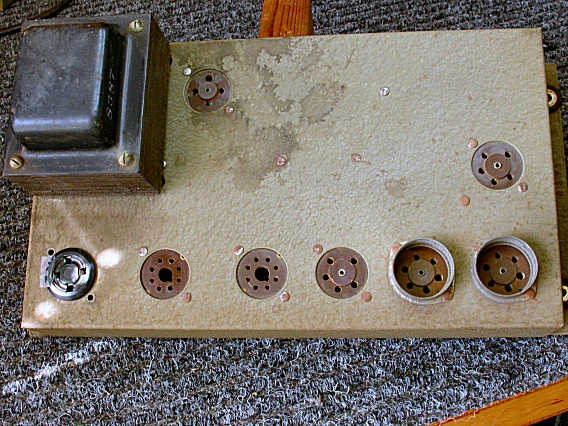| BustedGear.com |
| Shop | Repairs | Manufacturers | Resources | iFAQs | About |
|
|
|||
| Epiphone® Electar Zephyr | 1: Loudspeaker & Tubes | ||
|---|---|---|---|
|
Last Page < |
Page Bottom ∨ |
Next Page > |
|
|
|
|||
|
This photo shows the Zephyr's amp chassis during a final test run. Although the chassis is removed from the Zephyr cabinet, we have it powered up and connected to the control panel and loudspeaker. |

|
|---|---|
|
A 4-pin plug connects the chassis to the loudspeaker and a 5-pin plug connects it to the control panel. The Zephyr's 12-inch “field-coil” speaker was made by The Rola Company of Cleveland OH. |

|
|
► Four wires, not two, connect to the speaker. That's because two electric coils are inside : a “voice” coil and a “field” coil. ● All speakers contain a voice coil that is situated in a steady magnetic field. ● When AC signals vibrate in the voice coil, a fluctuating magnetic field is produced. This fluctuating field interacts with the steady field causing the voice coil (and an attached speaker cone) to pulse forward and back. The pulsing cone produces a wave of air pressure that we call sound. ● Most speakers use a permanent magnet to produce the steady field but this speaker uses DC current through its field coil to produce the steady magnetic field. |

|
|
The tubes used in this early 1940's Zephyr amp (S/N 8372) differ from those used in many Zephyr models. In this photo, you can see the Zephyr's six vacuum tubes. From foreground to background they are:
|

|
|
This is a close-up of the ‘6C6’ preamp tubes, with their metal shields and top, cap-connected control grids. Connecting via the tube's top provides greater circuit stability by isolating the low-level control grid signal from the rest of the tube's connections. |

|
|
Here you see the Electar Zephyr chassis with the vacuum tubes and interconnect cables removed. |

|
|
These are the tubes we removed from the early-40's Electar-Zephyr guitar amp (serial # 8372). All the tubes tested good.
● Check out our Tube Pinout Sheets for pin-out diagrams of all these tubes. |

|
| Epiphone® Electar Zephyr | ||
|---|---|---|
|
Last Page < |
Page Top ∧ |
Next Page > |
|
|
|
|
|
Page design and content Copyright © Richard Diemer - All rights reserved |